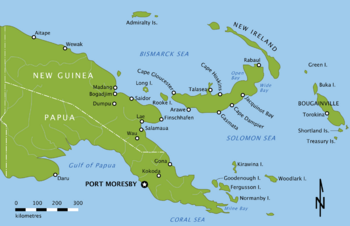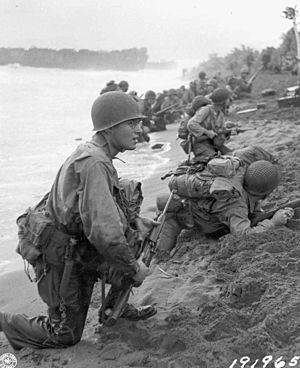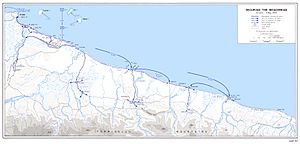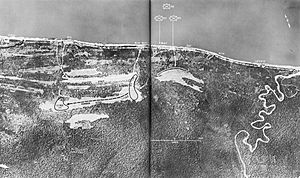Landing at Aitape facts for kids
Quick facts for kids Landing at Aitape |
|||||||
|---|---|---|---|---|---|---|---|
| Part of the New Guinea Campaign | |||||||
 Troops unloading supplies at Aitape |
|||||||
|
|||||||
| Belligerents | |||||||
| Commanders and leaders | |||||||
| Units involved | |||||||
|
|
||||||
| Strength | |||||||
| 22,500 | 1,000 | ||||||
| Casualties and losses | |||||||
| 19 killed 40 wounded |
525 killed 25 captured |
||||||
The Landing at Aitape was an important battle during World War II. It was part of the Western New Guinea campaign. On April 22, 1944, American and Allied forces landed by sea at Aitape. This town is on the northern coast of Papua New Guinea.
This landing happened at the same time as other landings nearby. The main goal was to take control of Hollandia. This would cut off the Japanese 18th Army stationed at Wewak. The operations to secure the area continued until May 4, 1944. Aitape later became a key base for Allied forces. Australian troops used it in 1944 and 1945.
Why Aitape Was Important
Aitape is on the northern coast of New Guinea. It is about 125 miles (200 km) southeast of Hollandia. Japanese forces took control of Aitape in December 1942. They built an airfield called Tadji Airfield nearby.
Throughout 1943 and early 1944, the Allies worked to isolate the main Japanese base at Rabaul. As the Allies planned to move towards the Philippines, they learned that Aitape was not heavily guarded. In March 1944, General Douglas MacArthur decided to invade Aitape. This would allow them to bypass large Japanese forces at Hansa Bay and Wewak.
The main goals for taking Aitape were:
- To cut off the Japanese 18th Army at Wewak. This army was led by General Hatazō Adachi.
- To protect against any Japanese movement towards Hollandia.
- To secure Tadji Airfield. This airfield was needed to support the more important landings at Hollandia.
- To set up small naval facilities at Aitape. These would help with future military operations.
About 217 ships and 23,000 support staff helped with the operation. They transported 52,000 soldiers, their equipment, and supplies. This journey covered over 1,000 miles (1,600 km) into Japanese territory. About 22,500 soldiers were assigned to the Aitape landing. Lieutenant General Walter Krueger was in charge of the whole Allied operation. He commanded the Sixth United States Army. The Japanese troops in the Aitape area were thought to be around 3,500. Only about 1,500 of these were combat troops. They were part of Shigeru Katagiri's 20th Division.
American naval ships, led by Vice Admiral Marc Mitscher, attacked Japanese bases. They bombed Sawar, Wadke Island, Hollandia, and Sarmi on April 21 and 22. This was done to weaken Japanese defenses before the troops landed. Other US and Australian naval ships also provided direct support. Eight small aircraft carriers gave air support. Several US Army Air Force bomber squadrons were also ready to help. Five destroyers and other ships provided gunfire support near the landing beaches.
The Landings Begin
The Allied ground forces for Aitape were led by Brigadier General Jens A. Doe. His main unit was the US 163rd Infantry Regiment. This regiment was part of the 41st Infantry Division. It turned out there were only about 1,000 Japanese soldiers in the area. Most were anti-aircraft gunners or support staff. Only about 240 were combat troops. This was much fewer than expected.
The Allied ships and troops gathered at Cape Cretin in mid-April. They practiced their landing near Lae. The plan was to land at Aitape, Humboldt Bay, and Tanahmerah Bay all at the same time. The three groups of ships met near Manus Island on April 20. They sailed together until early morning on April 22. Then, the Aitape group turned towards its target.
The landing was planned for "Blue Beach," a 1,200-yard (1,100 m) beach. It was about 1 mile (1.6 km) from Tadji Airfield. Heavy smoke from fires on the beach made it hard to see. The landing craft crews got confused and landed in the wrong place, at Wapil. Two battalions of the 163rd Regiment landed in nine waves. They met only light resistance. Most Japanese defenders ran into the hills.
After the beach was secure, the Royal Australian Air Force (RAAF) went ashore. They started repairing Tadji Airfield on the morning of April 22. General MacArthur watched the landings from a ship. He then went ashore in a landing boat.
The main airfield was secured by 1:00 PM on April 22. On April 23, soldiers secured the unfinished Tadji west strip. The RAAF quickly made the fighter strip ready for use. On April 24, twenty-five P-40 planes from the RAAF landed there. The rest of their planes arrived the next day. They provided air support for the Aitape and Hollandia landings. The 163rd Infantry Regiment moved west of the airfield. They met little resistance and had only two casualties.
More Allied troops arrived on April 23. The 127th Infantry Regiment from the 32nd Infantry Division joined the forces. On April 24, infantry and tanks moved further west. They crossed the Raihu river easily. They reached Aitape town and Rohm Point, which the Japanese had quickly left.
Allied troops then moved up the Raihu river. They wanted to find any remaining Japanese soldiers. These soldiers hoped to go east towards Wewak or west towards Vanimo. On April 28 and 29, the 3rd Battalion reached Kamti village. Here, they found the only organized Japanese resistance before May 4. About 200 Japanese soldiers attacked them. The Japanese suffered heavy losses, with about 90 men killed. The 3rd Battalion lost only 3 men and had 2 wounded. On April 30, the men at Kamti pulled back. Artillery fired 240 rounds into the village. The next morning, Company L, 163rd Infantry Battalion, returned to Kamti without resistance. There were few other clashes with the Japanese on the west side. By early May, troops from the 32nd Division took over all outposts of the 163rd Infantry Battalion.
What Happened Next
After securing the area around Aitape and Tadji Airfields, American troops began exploring east of Tadji. They were looking for any possible counterattacks from the Japanese 18th Army. The Japanese 20th Division started digging in near Suain in early May. They wanted to slow down any American advance eastward.
On May 10, RAAF planes from Tadji Airfield bombed Japanese positions. On May 12, the 127th Infantry Regiment found the first Japanese defense lines. They came under heavy mortar and machine gun fire. The Americans fought back and moved several miles forward. But they found the Japanese were stronger than expected. They decided to pull back on May 14 after strong Japanese counterattacks.
The Japanese became worried about this threat on their western side. They decided to attack. From May 15 to June 5, the 127th Infantry Regiment had to retreat. They first went to Babiang, then to Nyaparake and Parakovio. They could not hold these positions either. They had to leave on May 24. Finally, they tried to stop the Japanese at Yakumol on June 4. But they were forced to retreat by sea the next night. They set up a new defense line along the west bank of the Driniumor River. Hundreds of Japanese and dozens of Americans died during these fights.
These strong Japanese attacks, plus captured documents, showed something big was coming. The Japanese 18th Army planned to retake Tadji Airfield. This would slow down the American push towards Western New Guinea and the Philippines.
In June, American forces strengthened their positions along the Driniumor River. Some patrols went east of the river to keep an eye on the Japanese. The Japanese kept moving more troops from Wewak to the area. This led to the Battle of Driniumor River in July. Heavy fighting continued through July and into early August. Then, the Japanese started to retreat as they ran out of food and ammunition.
The fighting from late April to early August caused many more casualties than the initial landing. About 440 Allied soldiers were killed, and 2,550 were wounded. The Japanese lost about 9,000 of their 20,000 soldiers. In November 1944, Australian forces took over from the US troops at Aitape. From then until the end of the war in August 1945, they fought a limited campaign in the Aitape–Wewak area. They used Aitape as their base as they advanced towards Wewak.





